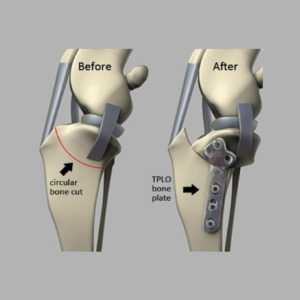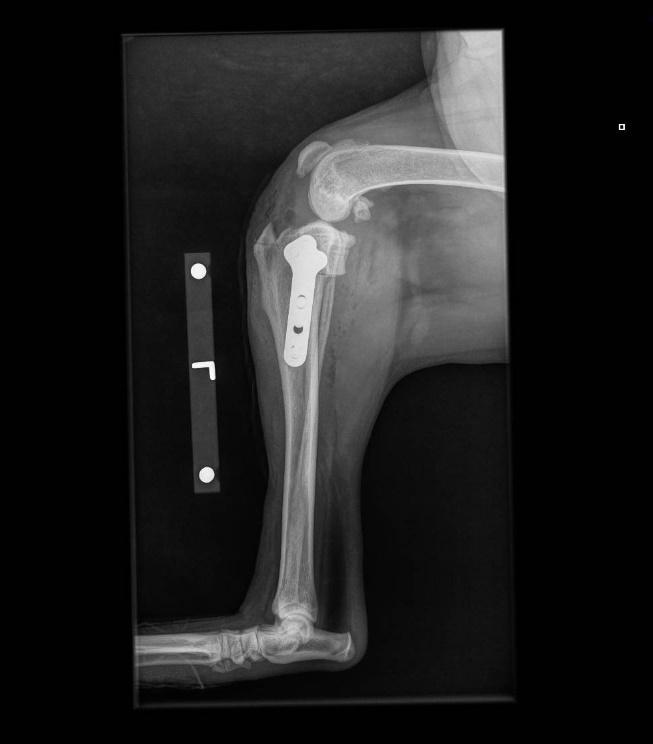TPLO (Tibial Plateau Leveling Osteotomy) in Dogs
Cranial cruciate disease is the most common orthopedic problem in dogs.
If your dog has been diagnosed with a torn cranial cruciate ligament, you will probably be considering surgical treatment options that will include the tibial plateau leveling osteotomy (TPLO).
This article will deal only with the specifics of the TPLO.
How is the TPLO performed?
Before surgery, an x-ray of the stifle (knee) is taken to measure the angle at the top of the shin bone, called the tibial plateau angle. The goal of the surgery is to reduce this angle so that dynamic joint instability (cranial tibial thrust) is eliminated. This is usually accomplished by creating a post-surgical angle of approximately 6 degrees. The surgical procedure starts with an exploration of the inside of the stifle joint. The purpose is to confirm the diagnosis of a cranial cruciate tear, debride (remove) torn fragments and to assess the meniscal cartilages for any possible damage. Damaged cartilage must be removed if the dog is to regain normal pain-free function. The TPLO procedure itself involves the use of a curved saw blade to make a curved cut on the inside, or medial, surface of the top of the tibia. The cut top portion is then rotated to create the desired tibial plateau angle. A stainless steel bone plate is then placed on the bone to hold the two pieces in their new alignment.

Please find some common questions about the procedure below.
Does My Dog Really Need Surgery? I Read That They’ll Do Just Fine Without Surgery.
Published data suggest that approximately 15% of dogs will recover reasonably good clinical function without surgery. Most of those dogs will be small breeds, under 15 pounds of body weight. Those that recover normal function tend to do so within 4-6 weeks after they first become lame. For the majority of dogs, surgery is the only way to return them to normal exercise levels and function.
Which Patients Will Benefit From TPLO?
While the procedure can be performed on just about any patient, including small dogs and cats, TPLO seems to be most applicable to heavier, larger and/or active dogs. Although some surgeons have differing opinions, most feel that smaller dogs will do equally well regardless of what procedure is performed. In general, dogs weighing over 25 pounds, especially if they are very active, will benefit the most from TPLO.
Why Is TPLO So Costly, Especially When Compared To Other Cruciate Repair Surgeries?
TPLO requires specialized equipment including a motorized bone saw with a specially-designed curved blade, a surgical stainless steel bone plate and 6-8 bone screws, between 4-6 x-rays, a significant investment in training on the part of the surgeon, and up to 2-4 hours of preparation, surgical and recovery time for each patient.

What Aftercare Is Required?
The recovery process involving activity restriction is for a total of 8 weeks. During this time period, pets must be confined to a small, safe area (such as a crate or small room without furniture). There is absolutely no running, jumping or playing during the 8 weeks and when outside, your pet must always be on a leash. The first two weeks after surgery require the strictest activity restriction, with dogs only being allowed to walk on a leash for 5 minutes or less for bathroom breaks. An elizabethan (cone) collar must be worn for the first two weeks to prevent licking at the incision. After two weeks, dogs are allowed to start leash walks two to four times daily, 10-15 minutes at a time under the owner’s control. Confinement within the home must continue.
At the 8 week post-operative period, all patients will require follow-up x-rays at to gauge healing of the cut in the bone. Once bone healing is complete, then exercise can be gradually increased to normal.
What About Possible Complications?
TPLO is a major surgery and complications are possible. Most complications are considered minor and can be resolved without additional surgery and have an ultimately successful outcome. Included in this category are incisional infections and inflammation of the patellar tendon. More major complications, including failure of plates or screws and fracture of the tibia or fibula, are uncommon.
One of the most common post-operative complications is not directly related to the TPLO procedure. Tears of the meniscal cartilage in the stifle are a common consequence of an unstable joint. Such tears may exist at the time of surgery and are reported to develop in approximately 5% of patients after surgery. This can occur in dogs, regardless of surgical stabilization procedure they undergo. Typically, these patients do well for weeks or months after surgery before suddenly becoming lame again. Most often, a click or popping sound is heard when the pet is walking. Treatment consists of going back into the joint only to remove the portion of the torn meniscal cartilage.
Is TPLO Really Better Than Other Surgical Options?
If your dog is larger, younger and/or active the answer is yes.
In the last few years, the research data is starting to confirm TPLO dogs return to function faster, they develop less joint arthritis, and they tend to return to better functional levels than is seen with other stabilization techniques.
